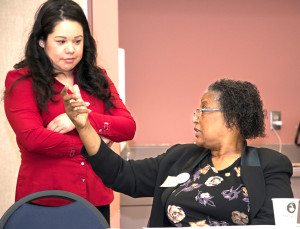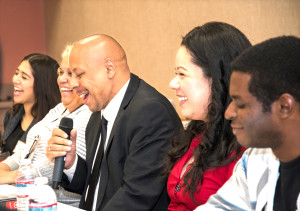Free tax preparers try to get the most for low-income filers

Inland Empire Regional Campaign Director for the Golden State Opportunity Fund, Blanca Lopez (left), and VITA Volunteer Dewey Kelleygrey discuss the impact the CalEITC has had since it was approved in 2015 before a panel discussion held in San Bernardino on Wednesday, March 8. INQUIRER/Eric Licas
LOS ANGELES — Even though Dewey Kelleygray has been preparing taxes for over 50 years, many of the taxpayers who come to her for help retain some skepticism. She said they have a hard time believing that the free services provided by the Volunteer Income Tax Assistance (VITA) program will be as thorough as those offered by paid professionals.
“They’re afraid of free,” said Kelleygray with a light tilt to her brow. “There’s always a catch, until they come to VITA and find out that it doesn’t cost anything and the quality surpasses paid services.”
She said private tax preparers often charge per document filed, so they might not apply for certain credits if the return would amount to less than their fee.
She and other IRS certified volunteers for VITA, however, will file every applicable form for their clients because they don’t have to turn a profit on them.
Volunteers like Ronald Hall say they do it because they enjoy helping people. He went on to say that he’s been surprising many of his clients this year and delivering a lot of good news.
Earned Income Credit surprise
“That’s due to the earned income credit (EITC),” he said “They didnt’ expect to get so much back.”
Households that earn less than $54,000 a year qualify for both VITA services and the federal EITC. Additionally, 2017 is the second year that California has made a separate, state funded earned income credit available to families and individuals who made less than $14,000.
Last season, nearly $200 million were distributed to about 377,000 low-income households that applied for the CalEITC. The average credited amount was around $500, but some families stand to earn almost $2,600 from the program.
Big boost to clients
Hall said that money often means a big boost to his clients. They often put it towards food, clothes and expenses for themselves and their children or other important purchases.
Last summer, Justin Redmond decided to take classes at separate campuses each located about 12 miles from his home, in opposite directions in hopes of speeding up his transfer to a four-year university.
He had bought a used car with money he had made working at a Dave & Busters restaurant in Ontario in order to make his commute to school manageable. It ran for about a month before breaking down early on during the Fall semester.

Left to right, VITA San Bernardino Program Manager Stephanie Maldonado, VITA Site Coordinator Enid Hernandez, VITA Volunteer Ronald Hall, Inland Empire Regional Campaign Director for the Golden State Opportunity Fund, Blanca Lopez, as well as student and first-time tax filer Justin Redmond share a light moment while describing the value of the CalEITC program during a press conference in San Bernardino on Wednesday, March 8. INQUIRER/Eric Licas
“It’s made it a lot harder for me to study. I’ve had to learn to adapt and do work on the bus,” said the aspiring biologist. “Sometimes the bus is cool, it’s clean and nobody’s on there, but sometimes there’s a bunch of people making noise, y’know drunk people, or whatever.”
Redmond wasn’t sure how long it would be before he could get his car running until he learned about the VITA program and found out that he was eligible for a substantial refund. Thanks to the unexpected funds, the first-time taxpayer will be able to set aside money to cover part of his expenses when he transfers to a four-year university at the end of the semester in addition to the $500 repair bill for his ca
Last year, only 67 percent of those who qualified for the CalEITC filed their taxes. The deadline to take advantage of both the federal and state credits is coming up on Tuesday, April 18.
People can learn more about the incentives they qualify for at CalEITC4Me.org. Those who would like to schedule an appointment or learn more about tax preparation services can also perform a web search to find the contact information of their local VITA tax site.
Inland Empire Regional Campaign Director for the Golden State Opportunity Fund, Blanca Lopez (R), and VITA Volunteer Dewey Kelleygrey discuss the impact the CalEITC has had since it was approved in 2015 before a panel discussion held in San Bernardino on Wednesday, March 8.







